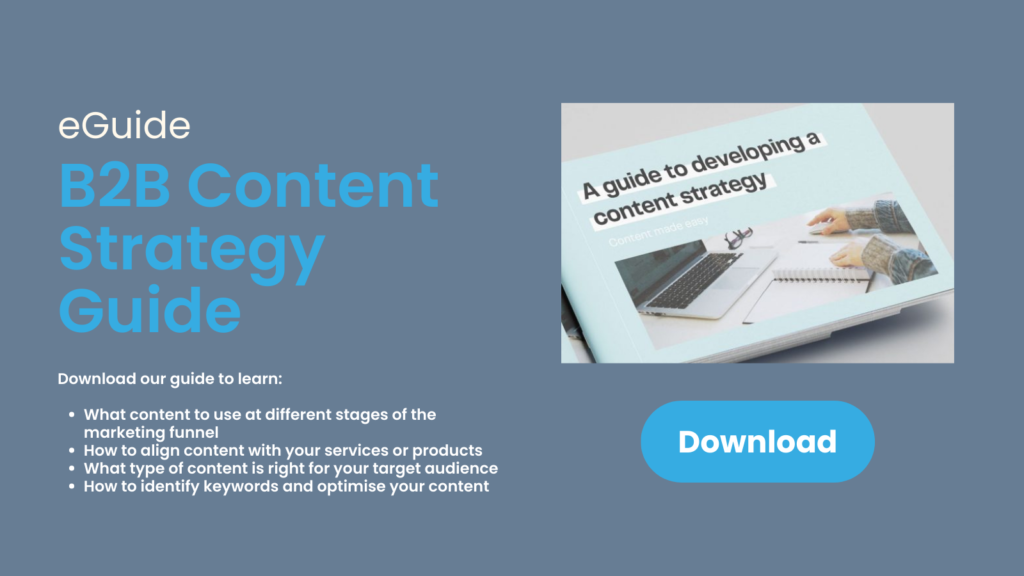If, like many marketers in the B2B space, you’ve been prioritising TOFU (top of the funnel) content, perhaps it’s time to flip your funnel and start at the bottom?
I recently read that only 4.3% of content is created for the bottom of the funnel (BOFU), which didn’t entirely surprise me as many marketers focus on the top of the funnel in order to bring as many people into it as possible. Leads created at the top and middle of the funnel are then passed to sales to convert into customers.
As a result BOFU content can be thin on the ground, and marketing may be missing a trick. Why?
Because:
a) your sales team doesn’t want to waste time on marketing qualified leads (MQL) from the top and middle of the funnel who are often not ready to commit, and
b) there are unknown leads searching for BOFU content who will deliver a higher ROI if you just provided them with the content they need to make a buying decision.
Let’s explore the points above in a little more detail.
B2B marketers need to deliver better leads to sales
The sales cycle for many B2B solutions and services can be long, especially in areas like IT where I’ve worked in recent years. It can be months between a lead requesting a proposal to them signing a contract. If that’s long, then just think of the time it may have taken that lead to get to proposal stage!
This could be potentially weeks or months of researching different options before they’re ready to actively engage with your sales team. And this research is not just the TOFU and MOFU type stuff, such as searching for answers to particular challenges or educating themselves about a specific technology or service.
In this time they are also researching your company and your people, and trying to get a better understanding of whether you will meet their expectations. At this stage, BOFU, they are interested in content that explains what the engagement or customer experience is like, service transition and onboarding information, pricing, SLAs, testimonials, relevant / relatable case studies and customer stories, and content about ROI and payback periods.
Meeting the needs of unknown BOFU leads
The second reason why B2B marketers are missing a trick is that you have no control over when potential customers enter your marketing funnel. They don’t all start at the top. They might have started their journey at the TOFU stage on a competitor’s site and found everything they need there. Maybe they’re now identified the solution or service they want and are comparing a few different providers for due diligence. Your marketing content will need to work very hard to make up lost ground – when they’ve already started to build trust with another provider.
But if you do it right, your BOFU content will deliver a much higher ROI than your TOFU and MOFU content. That’s because leads at this stage of the funnel are ready to buy. They’ve done their research, they know what they want, they just need to be pushed over the line.
Bottom to top
When developing a content journey / funnel, my approach is to start at the bottom and work my way up.
If you don’t have BOFU content published, you may get lots of page views for your TOFU content and perhaps some click throughs or downloads to your MOFU content, but then you start haemorrhaging leads because they’re not ready to reach out to your business directly and there’s nowhere else for them to go.
For this reason it makes sense to flip the funnel and work backwards. This way when you create your TOFU content there will already be MOFU and BOFU content in place, and everything is aligned with your key objectives to convert leads into customers.
My recommendation is to always start with a real customer, someone you would like to replicate a thousand times over. Speak to your sales team about the questions they had and the information they requested prior to closing the deal. If possible arrange an interview to find out what content they found useful, and what they would have liked to see. Use this insight to develop your BOFU content for the solution or service they purchased, and at the same time get a case study and testimonial if you haven’t already.
If you have the data you can also review how the customer engaged with your business throughout the journey. What content did they look at, what keywords did they search with, when did they first engage directly with you and how? Apply all this insight throughout the funnel so that you can attract, engage and convert more customers like them.
You don’t need as much BOFU content, but it needs to be good
Returning to the Backlinko metric about how little content is created by marketers for the bottom of the funnel. While 4.3% is too low, you don’t need as much BOFU content as you do TOFU and MOFU.
That’s because earlier in the funnel prospects are searching for a wider range of content. At this stage they might not even know what the solution they need is. They could be searching with a problem or desire, looking for advice, exploring different approaches and educating themselves about solutions.
TOFU and MOFU content helps them self-qualify for the solution or service your marketing funnel is designed for, and therefore as they progress through the funnel your content becomes more focused towards the end goal.
If you put in place really good quality BOFU content from the start, you can then keep topping up your TOFU and MOFU content to attract more prospects via search, social media, email, PPC, etc. Which is probably good news for many B2B marketers as this is the content we love creating!
Content Life monthly newsletter
This article was inspired by my travels around the world of B2B content marketing when I was researching my first Content Life newsletter – published last Friday. This monthly newsletter shares 5 pieces of inspiring or practical content about, surprise surprise, content marketing from thought leaders and creators. If you are a B2B marketer I think you’ll find it useful. You can subscribe here >





